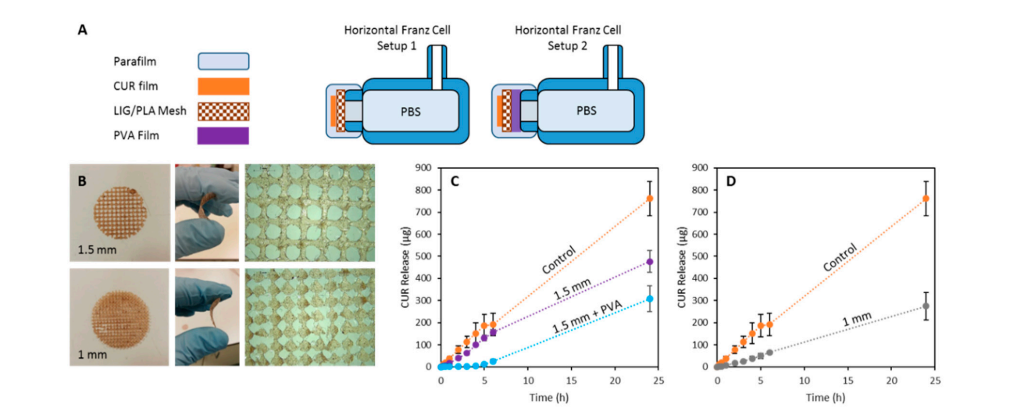 As innovation in materials grows into a vast science—especially within the 3D and 4D printing realms, medical patients of today and the future can look forward to improved, patient-specific care. Researchers from Queen’s University Belfast study the implications and potential with enhanced PLA in ‘Antioxidant PLA Composites Containing Lignin for 3D Printing Applications: A Potential Material for Healthcare Applications.’
As innovation in materials grows into a vast science—especially within the 3D and 4D printing realms, medical patients of today and the future can look forward to improved, patient-specific care. Researchers from Queen’s University Belfast study the implications and potential with enhanced PLA in ‘Antioxidant PLA Composites Containing Lignin for 3D Printing Applications: A Potential Material for Healthcare Applications.’
Lignin (LIG) is a natural biopolymer containing antioxidants. To see if these properties would carry through after serving as a coating for PLA pellets and then being 3D printed, the researchers placed the material into an extruder at 200 ◦C. Their suppositions proved correct as not only did the filament work successfully, but it passed on antioxidants.
“A wound healing model compound, curcumin (CUR), was applied in the surface of the mesh and its diffusion was studied,” stated the researchers. “It was observed that the dimensions of the meshes affected the permeation rate of CUR. Accordingly, the design of the mesh could be modified according to the patient’s needs.”

Photographs of: PLA and PLA coated pellets (A); LIG and TC containing PLA filaments (B); LIG and TC containing 1 cm × 1 cm squares prepared using 3D printing (C); and different shapes printed using the filament containing 2% (w/w) LIG (D).
The use of PLA is popular for many reasons, beginning with its percieved biodegradability factor, and lack of toxicity. Suitable for FFF 3D printing, the vegetable-based filament can be combined with other molecules and has shown increasing merit for medical applications, especially in accelerating healing of wounds. This type of study has not been expansive previously, however, harnessing the power of lignin’s antioxidant and antimicrobial properties. Lignin is of interest as an extremely abundant polymer that the researchers contend is highly unexploited. It is an affordable material to acquire and use, and useful in a variety of other applications currently.
The researchers used different types of mesh with a 2 percent combination of LIG in the PLA, along with curcumin (CUR) applied in the material and diffused. They discovered better effectiveness with the meshes when using a size of 1mm. The research team also found that the release rate was delayed if they used both the mesh and a soluble PVA film, printed with the mesh on an FDM 3D printer with a dual extruder. The PVA film may also function in dual capacity as it not only delays the release of CUR, but also keeps the wound moist.
“A potential scenario for this material is as a wound dressing material due to the antioxidant activity of the composite material that can contribute to wound closure. Due to the low price of 3D printing equipment and its versatility, these materials can be used in hospitals to print wound dressings for patients on demand,” concluded the researchers.
“Due to the enhanced cell proliferation on antioxidant materials [16], these materials can be used for tissue culture applications or even for regenerative medicine. Due to the versatility of FFF, complex geometries can be prepared such as scaffolds. However, before this type of materials can be implanted into humans, the safety of lignin-based materials should be evaluated. It has been reported before that LIG-based materials are biocompatible [45] but more studies should be performed.”
3D printing continues to make substantial impacts in the medical arena, innovating for better ways to heal wounds, along with improving drug-delivery systems, and assisting in tissue regeneration. What do you think of this news? Let us know your thoughts! Join the discussion of this and other 3D printing topics at 3DPrintBoard.com.

Experimental setup used to measure drug diffusion trough the 3D printed meshes (A);
photographs of the 3D printed meshes made of PLA and 2% (w/w) LIG (B); and CUR release through
1.5 mm (C) and 1 mm (D) 3D printed meshes (n = 3).
Subscribe to Our Email Newsletter
Stay up-to-date on all the latest news from the 3D printing industry and receive information and offers from third party vendors.
You May Also Like
Precision at the Microscale: UK Researchers Advance Medical Devices with BMF’s 3D Printing Tech
University of Nottingham researchers are using Boston Micro Fabrication‘s (BMF) 3D printing technology to develop medical devices that improve compatibility with human tissue. Funded by a UK grant, this project...
3D Printing Webinar and Event Roundup: April 21, 2024
It’s another busy week of webinars and events, starting with Hannover Messe in Germany and continuing with Metalcasting Congress, Chinaplas, TechBlick’s Innovation Festival, and more. Stratasys continues its advanced training...
3D Printing Webinar and Event Roundup: March 17, 2024
It’s another busy week of webinars and events, including SALMED 2024 and AM Forum in Berlin. Stratasys continues its in-person training and is offering two webinars, ASTM is holding a...
3D Printed Micro Antenna is 15% Smaller and 6X Lighter
Horizon Microtechnologies has achieved success in creating a high-frequency D-Band horn antenna through micro 3D printing. However, this achievement did not rely solely on 3D printing; it involved a combination...






























